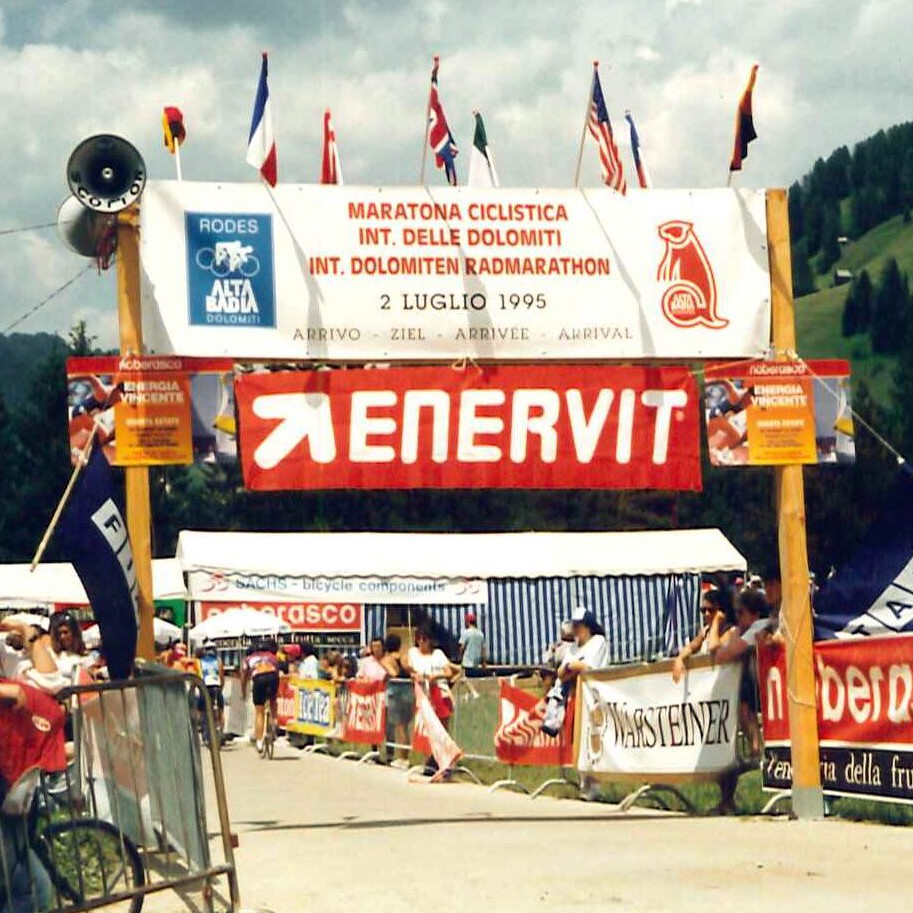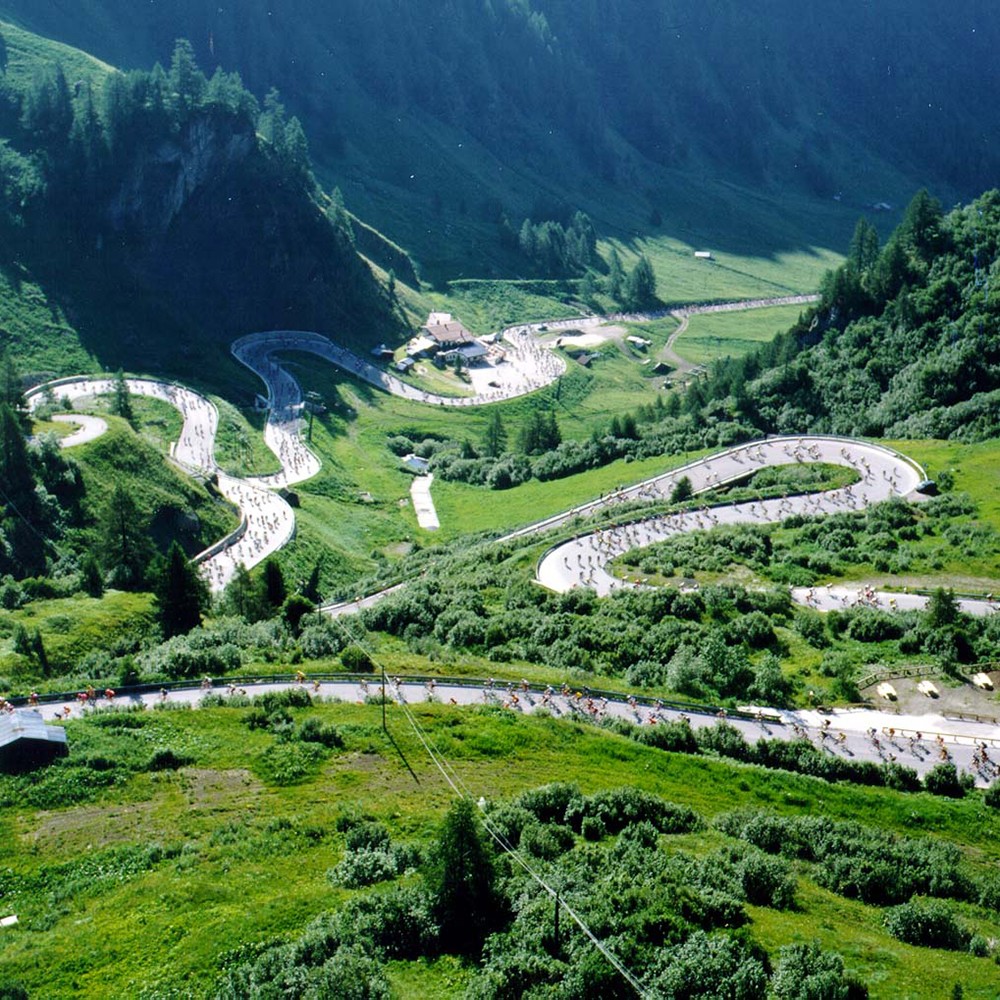5th edition
July 7th 1992
There were over 1000 participants – 1292 to be precise – of whom 32 were women and the Maratona finish line became electronic. The passages and times of competitors were recorded by a sign on the rear numbers and registered by IT systems.
The weather was bad once again: it poured down from Lake Misurina to Cortina. The hail was painful. Then the sun returned to shine on the winner, Rainer Emerich of Dobbiaco on the short route and Pasquale Fiscato, from Veneto, on the long route.
More: Statistics of the 5th edition

5th edition
July 7th 1992
There were over 1000 participants – 1292 to be precise – of whom 32 were women and the Maratona finish line became electronic. The passages and times of competitors were recorded by a sign on the rear numbers and registered by IT systems.
The weather was bad once again: it poured down from Lake Misurina to Cortina. The hail was painful. Then the sun returned to shine on the winner, Rainer Emerich of Dobbiaco on the short route and Pasquale Fiscato, from Veneto, on the long route.
More: Statistics of the 5th edition

6th edition
July 5th 1992
1992 was the saddest year in the history of the Maratona. 2583 signed up but only 1897 took part. The cold was biting and it rained heavily.
A serious road accident cost Luigi Nagler his life and injured Giovanni Fedrizzi.
More: Statistics of the 6th edition
7th edition
July 4th 1993
The Maratona’s success continued to grow exponentially. In 1993 there were over 3000 participants (3095 of whom 138 were women). For logistical reasons this was the last Maratona that left from Pedraces. It was the end of the pioneering era and a new modern era began for the most fascinating race in the world. This edition’s route was 160 km long, without the Giau Pass.
More: Statistics of the 7th edition

7th edition
July 4th 1993
The Maratona’s success continued to grow exponentially. In 1993 there were over 3000 participants (3095 of whom 138 were women). For logistical reasons this was the last Maratona that left from Pedraces. It was the end of the pioneering era and a new modern era began for the most fascinating race in the world. This edition’s route was 160 km long, without the Giau Pass.
More: Statistics of the 7th edition

8th edition
July 3rd 1994
1994 saw a new phase of the Maratona: there was such an increase in participants that the organisers decided to move the start of the race to Corvara.
5031 people took part – almost 2000 more than the previous year. There was a start time difference of over 16 minutes between the front of the group and the rear. It was a lovely day and the competitors felt the heat. 111 riders were caught without a helmet and were disqualified.
More: Statistics of the 8th edition
9th edition
July 2nd 1995
The Maratona continued to grow: 1995 saw 6674 people sign up - 1500 more than the year before. There weren’t enough numbers (6500 had been ordered) or jerseys: the former were printed hurriedly on a computer, while the latter were posted to competitors’ homes.
There were starting grids, with three groups of riders starting at different times.
More: Statistics of the 9th edition

9th edition
July 2nd 1995
The Maratona continued to grow: 1995 saw 6674 people sign up - 1500 more than the year before. There weren’t enough numbers (6500 had been ordered) or jerseys: the former were printed hurriedly on a computer, while the latter were posted to competitors’ homes.
There were starting grids, with three groups of riders starting at different times.
More: Statistics of the 9th edition

10th edition
July 7th 1996
1996 was an important year for the Maratona. The Maratona dles Dolomites Committee was formed and substituted the Rodes Alta Badia, with the arduous task of organising and foreseeing the ‘future’ of what was becoming a special event as part of a gran fondo cycle race.
6463 people signed up. There was bad weather, it rained and was cold on the Sella, but “the show must go on”.
More: Statistics of the 10th edition
11th edition
July 6th 1997
The first decision of the Maratona dles Dolomites Committee was to combine the race, on the 28th September the same year, with the first edition of The Terrific Alta Badia Race, named after local champion Maria Canins.
A brochure was printed for the first time and the week before the competition was filled with lots of events – not only linked to cycling.
More: Statistics of the 11th edition

11th edition
July 6th 1997
The first decision of the Maratona dles Dolomites Committee was to combine the race, on the 28th September the same year, with the first edition of The Terrific Alta Badia Race, named after local champion Maria Canins.
A brochure was printed for the first time and the week before the competition was filled with lots of events – not only linked to cycling.
More: Statistics of the 11th edition

12th edition
July 5th 1998
The growing success of the Maratona led the new committee to think of limiting numbers, although the competition retained the same format in 1998.
It was a splendid day and the help of volunteers made it a perfect race.
More: Statistics of the 12th edition
13th edition
July 4th 1999
1999 saw the introduction of the Datasport precision timing system, with Datachips that took readings in real time from start to finish.
The formula of a cyclists’ week gained even more ground, thanks to sports and entertainment events, as well as collateral events to the Maratona, including the Tenerific Maria Canins, a cycle race for kids aged 4 to 12.
More: Statistics of the 13th edition

13th edition
July 4th 1999
1999 saw the introduction of the Datasport precision timing system, with Datachips that took readings in real time from start to finish.
The formula of a cyclists’ week gained even more ground, thanks to sports and entertainment events, as well as collateral events to the Maratona, including the Tenerific Maria Canins, a cycle race for kids aged 4 to 12.
More: Statistics of the 13th edition

14th edition
July 9th 2000
2000 saw some great new features.
Firstly, from now on, each edition would have a motto, a key word, theme or special dedication. It began with Living is an Art and it was a great journey. The start was moved to La Villa and the Fedaia Pass was no longer part of the route.
The committee established a fixed number of 6000 participants. Over 30 nationalities took part. However, the edition was marked by a terrible accident: a competitor died while coming down the Giau Pass.
More: Statistics and results of the 14th edition































